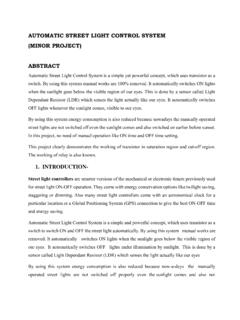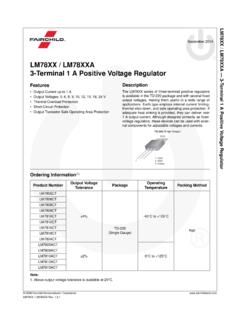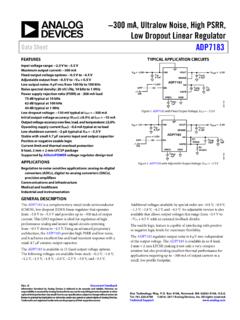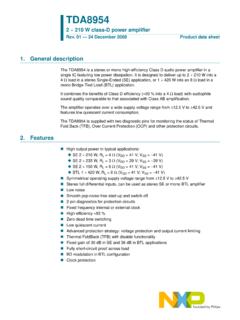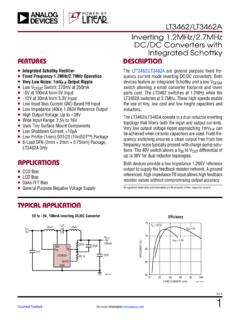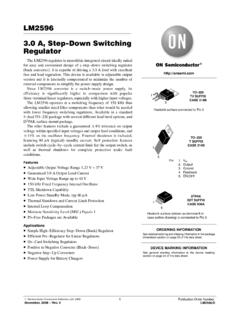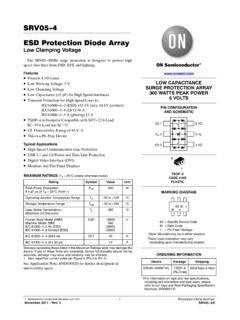Transcription of Total Solids, Volatile Solids - University of Florida
1 Total Solids , Volatile Solids Total Solids (TS)= Dry matter content of substrate Inverse of moisture content one of the most variable parameters between substrates water Volatile Solids (VS)= Combustible proportion of TS, organic matter Non- Volatile Solids (Ash)= Inorganic material (Minerals, salts), does not contribute to methane Moisture Volatile Solids Ash COD (Chemical oxygen demand) Chemical oxidant used to completely oxidize substrate Color indicator used to determine oxidant consumed Represents organic carbon in substrate Stoichiometrically related to methane potential CH4+2O2 CO2+2H2O Therefore 1 g COD = L methane @ STP COD represents the theoretical maximum methane produced from a substrate More accurate estimation than VS BOD (Biochemical oxygen demand) Similar to COD, but uses aerobic microbes to oxidize substrate Measures oxygen consumed during process Requires several days (commonly 5 days = BOD5) More realistic representation of microbially-available organic material Used widely in aerobic treatment to determine aeration requirement BMP (Biochemical methane potential) Assay developed as correlative test of BOD in anaerobic systems Determines actual methane production Accounts for non-biodegradable materials in feedstock ( lignin) Measures kinetics of methane production BMP Vial Gas Meter Organic loading rate (OLR) Rate at which feedstock is fed to the digester Units in kg VS (or COD)/m3/day or g VS (COD)/L/day Dependent on feedstock, reactor type, microbial population, temperature Too low= Unnecessarily large reactor ($$$)
2 Too high= overload reactor, acidification ( rate of acidogenesis exceeds rate of methanogenesis) Hydraulic Retention Time (HRT) Turn-over rate in digestion ( amount of time substrate remains in active volume) Optimized for highest biogas/reactor volume ratio Too high= Unnecessarily large reactor ($$$) Too low= Reduced biogas output, washout microbes Temperature Anaerobic metabolism more sensitive to temperature than aerobic Three primary temperature ranges Ambient: 10-25 C (50-77 F) Mesophilic: 25-45 C (77-113 F) Thermophilic: 45-60 C (113-140 F) Different microbial ecology at each temperature range Biogas output is greater at higher temps, but not linearly Each range has optimum temp for that microbial population pH Critical parameter Optimum , acceptable Methanogens cannot function at low pH Ammonia toxicity above pH can be maintained through addition of buffering agents (sodium bicarbonate, etc.)
3 , if required Dependent upon alkalinity of feedstock Acidification In anaerobic digestion organic acids are produced through acidogenesis, and drives pH lower Consumption of acids through methanogenesis keeps pH in balance If acidogenesis exceeds methanogenesis, acidification can occur Decrease in pH further inhibits methanogens, driving pH even lower (in a positive feedback loop) Slow recovery after sustained drop in pH Kinetics and substrate composition Carbohydrates Proteins Lipids Resistant Particulate Labile Particulate Soluble Recalcitrant Organics and Mineral Ash Type of materials in substrate determines digestion kinetics Pretreatment can increase kinetics For some substrates and digesters, kinetics are determined by hydrolysis rate Total organic matter (TCOD) fractioned between particulate matter (PCOD) and soluble matter (SCOD).
4 Only SCOD can be assimilated by microbes Hydrolysis converts PCOD to SCOD. Pretreatment can enhance solubilization by: Releasing endogenous SCOD Increasing availability to hydrolytic enzymes Pretreatment of apple Before grinding After grinding Pretreatment of bean Before grinding After grinding Pretreatment of broccoli Before grinding After grinding Pretreatment of potato Before grinding After grinding Different digester types Batch vs. continuous Wet vs. dry Two phase digestion CSTR UASB Bag digester Covered lagoon Egg-shaped digester Batch vs. continuously fed Batch Digester loaded once, emptied once fully degraded Continuously fed Digester loaded on a continuous basis, effluent produced at each loading Wet vs. dry digestion Wet Used for high moisture feedstocks Allows pumping of material Generally faster than dry digestion Dry AKA high Solids digestion Used for high solid materials ( MSW) Leachate recycling usually employed Typically a batch system Food waste can go either way Two phase digestion Single phase- all in one reactor Two phase- acidogenesis and methanogenesis separated Benefits Increased over-all efficiency (short HRT of acidogenic reactor)
5 More pH control of methanogenic reactor Two phase digestion CSTR Continuously-Stirred Tank Reactor Simple, common design UASB Up-flow Anaerobic Sludge Blanket Employs methanogenic granular sludge Ideal for wastewater digestion Bag digester Low materials and infrastructure input Ideal for developing nations Covered lagoon Plastic cover over new or existing manure lagoon Plumbing on and through cover captures biogas Convert existing infrastructure into a digester Egg-shaped digester Shape optimized for footprint space, sludge accumulation, mixing, and heating Generally used for activated sludge digestion Fixed Film Reactor Fixed media increases microbial population and microbe/substrate interactions Microbes form biofilm on media Higher methonogenesis= low HRT, high OLR, and decreased reactor size Benefits of biogas Sustainable energy Sustainable nutrients Scalable and local Reduces pathogens Waste diversion Benefits of Biogas Sustainable energy Carbon neutral Combats global warming Captures energy from waste No need for energy crops Offsets fossil fuel use Stretches energy reserves Sustainable energy Uses of biogas Cooking Heating (water/air) Electricity Gas lighting Vehicle fuel Hydrogen fuel cells Sustainable nutrients Nutrients converted to plant-available form Nutrient content depends on feedstock ( high protein=high N)
6 Can be injected into existing fertigation systems Avoids need for spreaders Can be diluted to required concentrations Sustainable nutrients Reduces use of synthetics Synthetics= fossil fuel derived Reduces cost of organic fertilizer Increased organic production Keeps nutrients within productive cycle Reduces runoff/ eutrophication Ideal for small farms implementing organic agriculture Facilitates urban agriculture Scalable and local Applicable to small farm or large city Biogas produced on-site or at centralized digester Sustainable energy in developing nations Reduces pathogens Anaerobic bacteria out-compete pathogens Huge benefit for human waste and manure Escherichia coli Salmonella typhimurium Diverting waste from aerobic treatment Problems with aerobic treatment High aeration energy input Loss of nutrients Transportation of biosolids Diverting waste from landfills Problems with organics in landfills Take up space Increased leachate problems Release of methane Lock-up nutrients Cause odor and vermin problems Transportation Landfill gas vs.
7 Biogas Landfill gas Slow, passive process Gas contaminated with many pollutants Transportation of waste to landfill Feasible option for existing landfill Biogas Fast, active process Gas significantly cleaner Energy AND nutrients Can be produced throughout community Saves landfill space Questions?
